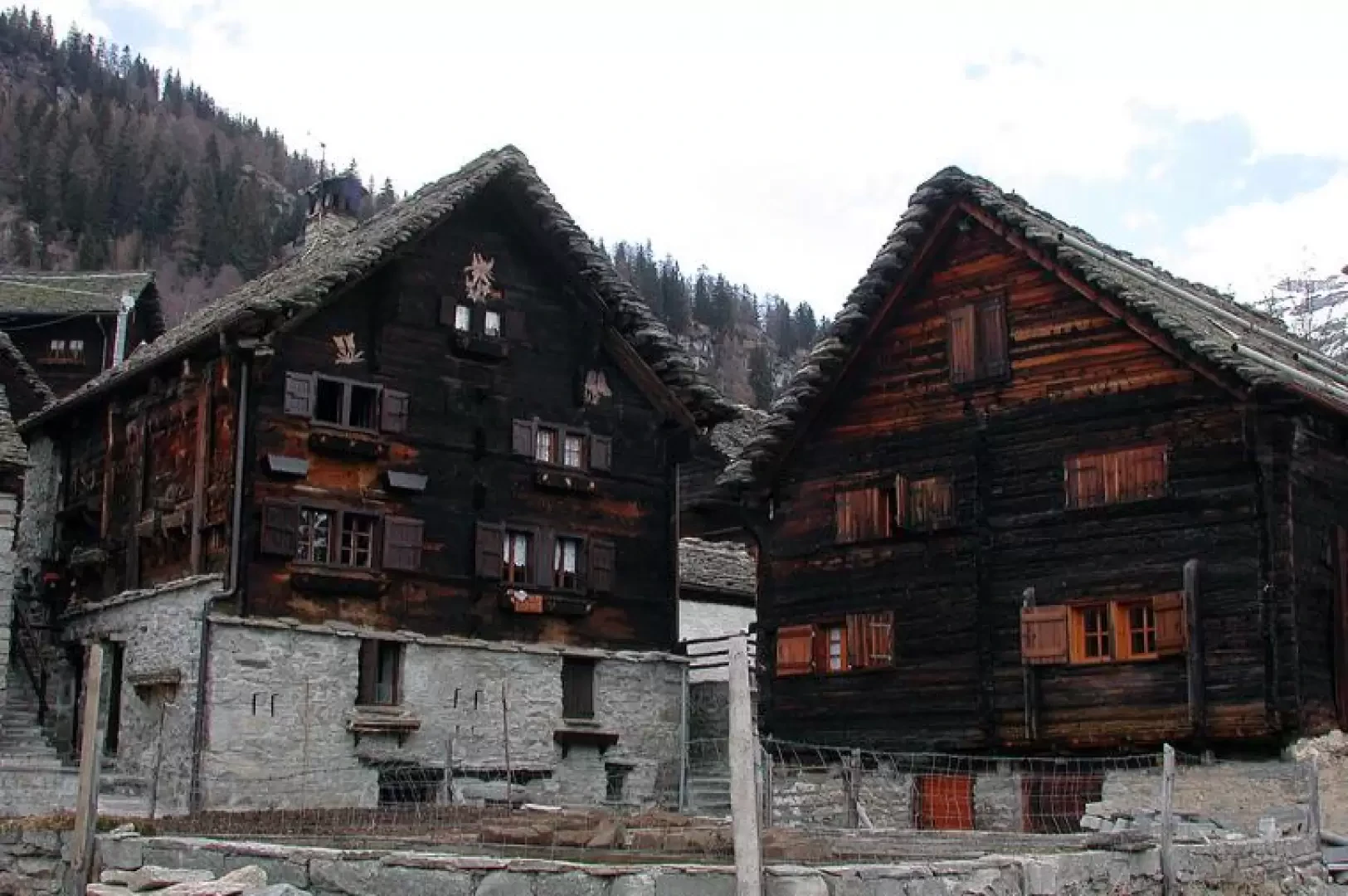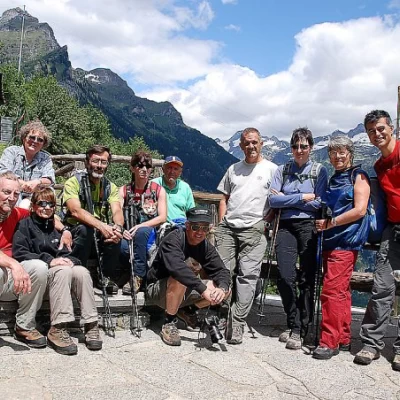Salecchio, from Pass

Introduction
Walking up the Antigorio valley, no one imagines that on the right, high up there are settlements; instead, the valley has a natural terrace suspended between 1300 and 1500 metres, and on this terrace a number of Walser settlements have sprung up since the 13th century, practically isolated from the rest of the world, keeping their language and traditions alive for centuries. The Walser (from the German Walliser, i.e. Vallesano) are a population of Germanic origin who immigrated from the Berne area into the Valais in the 8th century, and from there into the Italian valleys around Monte Rosa, into Switzerland, Austria, Liechtenstein and France from 1200 onwards, the year in which we find the first official documents relating to authorisations to settle in the area. They brought their culture, their skills as builders, their traditions and their language, a German dialect still spoken in their communities today. This immigration in the 13th century was due to a number of causes: the overpopulation of the Valais, a particularly favourable climatic period, which allowed settlements even in the mountains at high altitudes, special concessions by large monastic institutions and feudal lords to favour the colonisation of certain Valsesian areas. The first documents concerning Salecchio date back to 1200, when it was enfeoffed by one of the main families of the Antigorio valley, and later the seigniory passed from Novara to Milan. By 1588, the village had assumed such importance that it was endowed with its own statutes, but civil and criminal cases had to be heard before the curia of Domodossola, which was a source of great inconvenience. Moreover, the new feudal lords were too greedy, and the village rebelled, and a vicar was appointed with the power to judge small civil and criminal cases in the first instance. The inhabitants could neither read nor write, so they obtained a town secretary to come up from the valley floor to attend town councils; the care of souls was also very important to them, so they built a chapel and demanded a chaplain, which was not easy because not everyone understood their language. Every time they had to descend into the valley, they travelled 700 metres in altitude, and their speech is the most archaic among the Walser communities. They even maintained a special way of measuring time: the twelve hours of the night were counted by the evening sound of the Ave Maria, so in summer noon came later than in winter. Salecchio remained autonomous until 1928, when, after 700 years, it lost its autonomy and was united with Premia by a fascist decree. Life in the community was very hard, crops were scarce, rye, potatoes, flax, hemp, but the village was self-sufficient, and sold a few cheeses and a few goats in exchange for salt and basic necessities; to save on salt, water was supplied from a spring rich in minerals, and in Salecchio Superiore there were two mills and a hydraulic sawmill, in operation until 1956, which can still be seen. Meat was only eaten on Sundays, and bread baked a couple of times a year in the communal oven. At some point, however, the local resources were no longer able to maintain the 120 inhabitants of the 19th century, and a temporary migration began, which, due to changing living conditions, gradually became permanent, until the last permanent resident died in 1967. Today, thanks to some cable cars, and a track that reaches the Vova alp, many houses have been renovated and have returned to their former beauty.
Description
Leave the car at Passo (787m) and head along the tarmac road to Chioso, at about 2 km (896m), turn left onto the dirt road for Alpe Vova, and follow it until you cross the beautiful mule track that climbs gently between the trees with a constant gradient. We arrive at Rampignana, and admire a beautiful noble house on the left, then we pass the crossroads for Antillone, and continue our route partly on the dirt road, in the now beech forest; after about a couple of hours we find ourselves in front of the wide basin of alpe Vova. We did this tour on the 23rd of April, in a year when there was still snow along the north-facing sections of the trail. At Alpe Vova (1572m, 3h00'), we pass the small white church in the middle of a meadow, make a wide semicircle across the stream and go to the other side of the valley; the houses are very beautiful, and if it weren't for the light lines, photographing them in black and white would make it seem as if we were going back 300 years... We pass beautiful rascards, and look for the path that starts to the right of the road and continues flat on the hillside to Case Francoli (1555m), where there is another spring and a mound that used to be a lime kiln. The path continues with a stepped section, protected by a handrail, and almost on the level arrives at Salecchio Superiore (1509m, 0h45' minutes from Vova, 3h45').Before the village, on the right, along a stream, the sawmill and mills can be seen. The village is beautiful, with stone and wooden rascards, many houses are inhabited on Sundays, and traditions are revived every year with the celebration in Walser costumes of religious festivals, Candlemas, to celebrate the end of winter, the first Sunday in February, with a path beaten by snow groomers, and then on the First of May, the Assumption on the 15th of August. The Alpe Vova festival is on the first Sunday in July. Leaving Salecchio Superiore, we continue south on the path down to Salecchio Inferiore. Just outside the village, on the lower left, on the roof of an old rascard from 1645, flies the flag of the Zum Gora hut, in a very panoramic position. Our path crosses the pastures and reaches a small chapel, next to which, on a stone, are a few metal crosses; here too the view is beautiful; we continue downhill towards the houses of Salecchio Inferiore (1322m) and its delightful church; behind the church is a tiny cemetery with many small graves, because the inhabitants of the past, also because of the barely sufficient food, were more minute than us... Even in Piedicavallo, a small mountain village in the Biella region where I live, the cemetery niches are small and narrow... Before the church is the school. From Salecchio Inferiore, the trail makes a sharp bend to the north and we take the beautiful mule track that descends past a chapel and then turns into an ugly dirt road serving quarries. Follow it to the car (1h 30' from Salecchio Superiore, five and a quarter hours in total).
We have been there
Salecchio
21 giugno: sulle vie dei Walser a Salecchio
Inizio di estate con giornata variabile che non ha impedito di apprezzare il bellissimo scenario dei villaggi che sovrastano Premia.
Il percorso, in traversata, è iniziato a Chioso per risalire sino all'Alpe Vova: da qui inizia la bellissima traversata tra villaggi che hanno conservato lo spirito del popolo Walser.
Ringrazio tutti i 14 partecipanti per la bellissima giornata e rinnovo l'appuntamento a domenica 5 luglio: si sconfina in Francia alla caccia di riflessi del Mont Blanc sui Lacs de Cheserys.
Buona Montagna
Massimo
